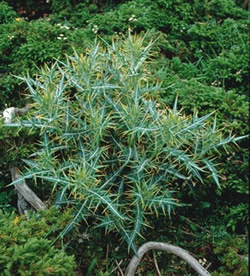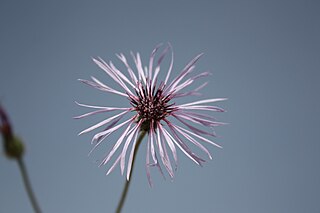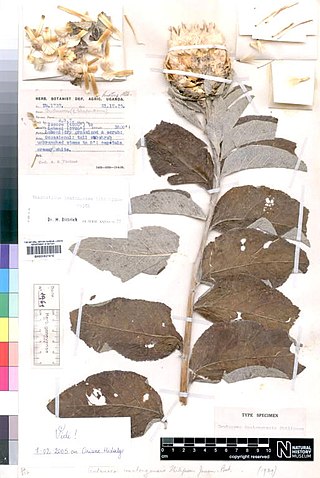
Centaurea is a genus of over 700 species of herbaceous thistle-like flowering plants in the family Asteraceae. Members of the genus are found only north of the equator, mostly in the Eastern Hemisphere; the Middle East and surrounding regions are particularly species-rich. In the western United States, yellow starthistles are an invasive species. Around the year 1850, seeds from the plant had arrived to the state of California. It is believed that those seeds came from South America.

Blechnaceae is a family of ferns in the order Polypodiales, with a cosmopolitan distribution. Its status as a family and the number of genera included have both varied considerably. In the Pteridophyte Phylogeny Group classification of 2016, the family has 24 genera, and excludes genera placed in the separate family Onocleaceae. The family is divided into three subfamilies, including Blechnoideae s.s. Alternatively, the entire family may be treated as the subfamily Blechnoideae s.l. of a very broadly defined family Aspleniaceae, and include genera others place in Onocleaceae.

Nepenthes tomoriana is a species of pitcher plant endemic to Sulawesi, where it grows at an elevation of 0–500 m above sea level.

Blechnum, known as hard fern, is a genus of ferns in the family Blechnaceae, subfamily Blechnoideae, according to the Pteridophyte Phylogeny Group classification of 2016. Two very different circumscriptions of the genus are used by different authors. In the PPG I system, based on Gasper et al. (2016), Blechnum is one of 18 genera in the subfamily Blechnoideae, and has about 30 species. Other sources use a very broadly defined Blechnum s.l., including accepting only two other genera in the subfamily. The genus then has about 250 species. In the PPG I circumscription, the genus is mostly neotropical, with a few southern African species.

The Cardueae are a tribe of flowering plants in the daisy family (Asteraceae) and the subfamily Carduoideae. Most of them are commonly known as thistles; four of the best known genera are Carduus, Cynara, Cirsium, and Onopordum.

Rhaponticum is a genus of flowering plants in the tribe Cardueae within the family Asteraceae.

Lamyropsis is a genus of Asia and European flowering plants in the family Asteraceae.

Filago is a genus of plants in the sunflower family, native from Europe and northern Africa to Mongolia, Nepal, and Macaronesia. They are sometimes called cottonroses or cudweeds.
In enzymology, a reticuline oxidase (EC 1.21.3.3) is an enzyme that catalyzes the chemical reaction

Centaurea tchihatcheffii is a species of flowering plant in the family Asteraceae. The flowers are most attractive as the pale or dark pinkish-red marginal florets take on an iridescent shimmer in the sun and wind, hence the vernacular name Yanardöner, meaning ‘iridescent flower’. It flowers from late April to mid-June and in cultivation even earlier, e.g., March in Istanbul. The peak flowering period is mid-May and in earlier years it was sold in some quantity by street florists in Ankara. It is mainly bee-, bug- and beetle-pollinated. Ants play an important role in seed dispersal and the fully ripe fat achenes are a delight for pigeons which settle down to feed in large flocks. The species is of taxonomic interest as it has some rather unusual and unique features not existing in any other Centaurea. For example, the marginal florets are funnel-shaped with crenate margins. The anther-tube is provided with glands at the tips of the appendages.
Hyalochaete is a genus of flowering plants in the daisy family.

Volutaria is a genus of flowering plants in the family Asteraceae. They range from Iberia to the Near East and East Africa, but are most diverse in the Maghreb.
Myopordon is a genus of flowering plants in the tribe Cardueae within the family Asteraceae.

Ochrocephala is a genus of Ethiopian flowering plants in the tribe Cardueae within the daisy family Asteraceae. Its only known species is Ochrocephala imatongensis, native to Ethiopia.

Josef Velenovský was a Czech botanist, mycologist, pteridologist, and bryologist. He also worked with fossils. He was a research investigator and professor in the Botanical Institute of the University of Prague, alternating with his colleague Ladislav Josef Čelakovský. He was also professor of botany at Charles University, where he concentrated in the study of mycology in final half of his life. Velenovský collected innumerable material, particularly in new central Bohemia, and described at least 2000 species of fungi. Many of his type specimens and other collections are located in the herbarium of the Národní Museum of Prague.
Emil Friedrich Knoblauch was a German botanist.

Psephellus is a genus of flowering plants in the family Asteraceae, native to eastern Europe and western Asia. A taxonomic revision reassigned many species from Centaurea to Psephellus.
Chamaepus is a genus of flowering plants belonging to the family Asteraceae. It contains a single species, Chamaepus afghanicus.
Centaurea demirizii, or Demiriz's centaury, is a herbaceous plant, a member of the family Asteraceae.













